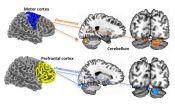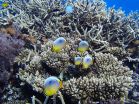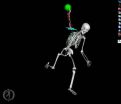(Press-News.org) In early childhood, the neurons inside children's developing brains form connections between various regions of brain "real estate." As described in a paper published last week in the journal Biological Psychiatry, cognitive neuroscientists at San Diego State University found that in children and adolescents with autism spectrum disorder, the connections between the cerebral cortex and the cerebellum appear to be overdeveloped in sensorimotor regions of the brain. This overdevelopment appears to muscle in on brain "real estate" that in typically developing children is more densely occupied by connections that serve higher cognitive functioning.
The study represents the first ever systematic look at connections between the entire cerebral cortex and the cerebellum using fMRI brain imaging, and its findings provide another piece in the puzzle that could one day lead researchers to develop a reliable brain-based test for identifying autism.
Back to the cerebellum
Several decades ago, scientists reported findings that certain regions of the cerebellum -- a brain region involved in motor control, but also in cognitive, social, and emotional functions -- were often smaller in people with autism than in typically developing people.
That sparked a brief flurry of research activity exploring the cerebellum's potential role in the disorder. Unfortunately, the direction never truly panned out for researchers hoping for a big breakthrough in understanding, said the study's corresponding author, SDSU psychologist Ralph-Axel Müller.
"Eventually, interest in the cerebellum waned due to a lack of consistency in the findings," he said.
Hoping that advances in brain imaging technology would reveal new insights, Müller, working with the study's first author Amanda Khan, looked back to the cerebellum for their study. Khan is a former master's student at SDSU and now a doctoral candidate at Suffolk University in Boston.
Over- and underconnected
The researchers directed 56 children and adolescents, half with autism and half without the disorder, to fixate on a focal point while thinking about nothing in particular, using fMRI brain imaging technology to scan the children's brains as they produced spontaneous brain activity. Capturing this spontaneous activity is crucial to honing in on what are essentially baseline neuronal patterns.
The imaging results revealed that the participants with autism had far stronger neuronal connectivity between sensorimotor regions of the cerebellum and cerebral cortex than did their counterparts without autism. Conversely, the participants with autism had less connectivity between regions involved in higher-order cognitive functions such as decision-making, attention and language.
The sensorimotor connections between the cerebral cortex and cerebellum mature during the first few years of life, when the brains of children with autism grow larger in volume than typically developing children, Müller explained. Connections that serve higher cognitive functions develop later, after this period of overgrowth.
"Our findings suggest that the early developing sensorimotor connections are highly represented in the cerebellum at the expense of higher cognitive functions in children with autism," he said. "By the time the higher cognitive functions begin to come online, many of the connections are already specialized. If a particular part of the brain is already functionally active in one domain, there may be no reason for the brain to switch it over to another domain later in life."
Neural neighborhood
Returning to the real estate metaphor, it's as if most of the available land has already been scooped up by sensorimotor connections before the higher-order cognitive function connections have a chance to move into the neighborhood.
The findings could help scientists and clinicians better understand exactly how abnormalities during brain development lead to various types of autism spectrum disorder. Müller hopes his work will not only contribute to a brain-based diagnosis of autism, but also be a step towards identifying its various subtypes and underlying genetic factors.
"We still don't understand what in the brain makes a kid autistic," he said. "You can't look at a scan and say, 'There it is.' We're doing the groundwork of finding brain variables that might be biomarkers for autism and its subtypes."
INFORMATION:
SDSU graduate students Aarti Nair and Christopher Keown, also contributed to the study, as did University of California, San Diego, graduate student Michael Datko and Alliant International University psychologist Alan Lincoln.
About San Diego State University
San Diego State University is a major public research institution offering bachelor's degrees in 89 areas, master's degrees in 78 areas and doctorates in 21 areas. The university provides transformative experiences, both inside and outside of the classroom, for its 34,000 students. Students participate in research, international experiences, sustainability and entrepreneurship initiatives, and a broad range of student life and leadership opportunities. The university's rich campus life features opportunities for students to participate in, and engage with, the creative and performing arts, a Division I athletics program and the vibrant cultural life of the San Diego region. For more information, visit http://www.sdsu.edu. END
A single infusion of an experimental anti-HIV antibody called 3BNC117 resulted in significantly decreased HIV levels that persisted for as long as 28 days in HIV-infected individuals, according to Phase 1 clinical trial findings published online today in Nature. Major funding for the research was provided by the Bill and Melinda Gates Foundation, The Rockefeller University, and supported in part by the National Institute of Allergy and Infectious Diseases (NIAID), a component of the NIH. The research was led by long-time NIAID grantee Michel C. Nussenzweig, M.D., Ph.D., ...
The four collaborating organizations are the American College of Nurse-Midwives; the American College of Obstetricians and Gynecologists; the Association of Women's Health, Obstetric and Neonatal Nurses; and the Society for Maternal-Fetal Medicine. Additionally, these organizations partnered with VitalSmarts, a research and training organization.
The report, "Transforming Communication and Safety Culture in Intrapartum Care: A Multi-organization Blueprint," follows previous research on safety concerns during childbirth and communication among labor and delivery teams. ...
Washington, DC--Pesticide exposure, not obesity alone, can contribute to increased cardiovascular disease risk and inflammation in premenopausal women, according to a new study published in the Endocrine Society's Journal of Clinical Endocrinology & Metabolism.
The study looked at the effects of exposure to polychlorinated pesticides such as DDT. Although DDT was banned in many countries in the 1970s, it remains widespread in the environment and food supply.
DDT was one of the first recognized endocrine-disrupting chemicals, according to the introductory guide to endocrine-disrupting ...
A collaboration led by Shigeyuki Yokoyama of RIKEN and Takashi Kadowaki and Toshimasa Yamauchi of the University of Tokyo has used the SPring-8 synchrotron facility in Harima, Japan to elucidate the structure of two receptors of adiponectin, a protein that is associated with obesity and diabetes. The researchers hope that in the future this work, which was published in Nature today, will pave the way toward designing drugs that target these two receptors, AdipoR1 and AdipoR2, to reduce the early mortality associated with diabetes.
Adiponectin, a hormone secreted by fat ...
In the first results to emerge from HIV patient trials of a new generation of so-called broadly neutralizing antibodies, Rockefeller University researchers have found the experimental therapy can dramatically reduce the amount of virus present in a patient's blood. The work, reported this week in Nature, brings fresh optimism to the field of HIV immunotherapy and suggests new strategies for fighting or even preventing HIV infection.
In a person infected with HIV, there is an ongoing arms race between the virus and the body's immune system. Even as the body produces new ...
In a feat that would have been unachievable only a few years ago, researchers at UC San Francisco have pulled aside the curtain on a protein informally known as the "wasabi receptor," revealing at near-atomic resolution structures that could be targeted with anti-inflammatory pain drugs.
Officially named TRPA1 (pronounced "trip A1"), the newly visualized protein resides in the cellular membrane of sensory nerve cells. It detects certain chemical agents originating outside our bodies--pungent irritants found in substances ranging from wasabi to tear gas--but is also triggered ...
A new scientific synthesis suggests a gradual, prolonged release of greenhouse gases from permafrost soils in Arctic and sub-Arctic regions, which may afford society more time to adapt to environmental changes, say scientists in an April 9 paper published in Nature.
"Twenty years ago there was very little research about the possible rate of permafrost carbon release," said co-author A. David McGuire, U.S. Geological Survey senior scientist and climate modeling expert with the Institute of Arctic Biology at the University of Alaska Fairbanks. "In 2011, we assembled an ...
Fish are the key ingredients in a new recipe to diagnose and restore degraded coral reef ecosystems, according to scientists from the Australian Institute of Marine Science, WCS, James Cook University, and other organizations in a new study in the journal Nature.
For overfished coral reef systems, restoring fish populations that perform key roles will in turn restore ecological functions critical to recovery. For moderately or lightly fished reefs, the recipe requires knowing which fish to catch, how many, and which to leave behind.
The authors assessed fish biomass ...
EVANSTON, Ill. --- A new approach to analyzing baseball-pitching biomechanics may one day give players more personalized feedback and help prevent elbow injuries.
In a computer simulation study of baseball pitching, Northwestern University biomedical engineers found that the strength of the elbow muscles of a baseball pitcher likely play a bigger role in injury risk and prevention than previously thought.
The motion analysis approach currently used in the baseball industry to provide athletes with injury-risk feedback is not sophisticated enough to estimate what an ...
April 8, 2015--Researchers at Columbia University's Mailman School of Public Health and Columbia Business School studied bed capacity --measured by the number of staffed beds -- in New York City hospital obstetrics units and found a significant excess number of beds, which overall cost the city an estimated $26.4 million each year. The findings, coupled with the current trends of an aging population and the declining birth rate, suggest that many obstetrics units could reduce their bed capacity and still assure timely access to care. Study findings are published in the ...



